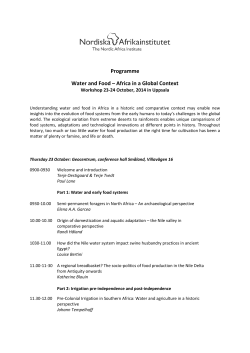
www.VIRAGROW.com
www.VIRAGROW.com Robert Morris Consultant for Viragrow, Inc. Table salt - Sodium chloride Table salt - Sodium chloride Epsom salts - Magnesium sulfate Fertilizers Saltpeter - Potassium nitrate De-icing salts - Sodium or potassium chloride Water softening salts – Sodium or potassium chloride Salt scrubs - Sea salt Soil Soil amendments Fertilizers Irrigation water Fertilizer Fertilizer Grade SI Urea 46-0-0 74.4 Ammonium sulfate 21-0-0 88.3 Calcium nitrate 15.5-0-0 65.0 Diammonium phosphate 18-46-0 29.2 Triple superphosphate 0-46-0 10.1 Potassium chloride 0-0-60 116.2 Potassium sulfate 0-0-50 42.6 Gypsum 0-0-0 8.1 Manure, 20% N 0-0-0 112.7 Source: A and L Labs, Great Lakes Solid table salt or sodium chloride Sodium ion Sodium Dissolved table salt Chloride Chloride ion Water in the lower Colorado River carries 1 ton (2000 lbs) of salts for every 320,000 gallons. Irrigating a 1000 square-foot tall fescue lawn in Las Vegas with Colorado River water applies about 600 to 700 pounds of salt to a lawn every year. Salt 1. Sample is taken from the field 2. Water from the soil is extracted from the soil sample 3. EC meter is adjusted against a standard 4. EC meter measures the soil water. If the salinity is too high to be read by the meter, the sample is diluted with distilled water in a 1:1 or 1:2 ratio. 5. Readings are adjusted to the dilution ratio Salinity standard EC or salinity meter Measurements of salinity may be in units commonly used by engineers (ppm), soil scientists (dSm/m) or horticulturists (mmhos/cm) Basic conversions are: 640 ppm = 1.0 mmhos/cm = 1.0 dS/m Salts containing sodium (Na) , chlorides (Cl), boron (B) and sulfates (SO4)can be troubling even before they get to concentrations that compete with the plant for water. For interior plants, fluorides (F) can be a problem. In irrigation water, bicarbonates (HCO3) can be a particular problem. Bad Guy Salts for Plants Sodium Chlorides Boron Flourides Bad Guy Salts for Steel and Concrete Sulfates Chlorides Bicarbonates Direct Damage • Indirect Damage • Wilting or leaf drop Plant quality gets worse Plant growth decreases Early Signs Temporary wilting midday Intermediate Signs Leaf yellowing (chlorosis) Leaf scorching or marginal/tip burn Intermediate Signs Leaf yellowing (chlorosis) Leaf scorching or marginal/tip burn Long Term Signs Leaf drop Stunting or reduced vigor Decrease in photosynthesis and energy production Decreased tolerance to high and low temperatures Lack of water Yellowing or chlorosis from fertilizer deficiency Stem, trunk or root damage Insect damage to the main trunk, stem or roots that stops water movement Diseases that stop water movement such as Phytophthora collar rot or Verticillium wilt Mechanical damage to the trunk from mowers or line trimmers Nematode damage to roots Eliminate other possible problems. Test the soil or water for salts. Where is the salt coming from? Soil? Irrigation water? Fertilizer? Soil amendment? Soil Problem Improve drainage Add organic soil amendments such as compost Flush out salts with good irrigation water (Leach, leach, leach) Use soil wetting agents Use salt resistant plants Use fertilizers with a lower salt index Irrigation Problem Blend irrigation water with better quality water or find a new source Switch from overhead to drip irrigation Improve irrigation uniformity Increase the amount of water applied Increase the frequency of irrigations, use multiple start times Water before the heat of the day Use salt resistant plants
© Copyright 2025





















